How to search the page
iOS Safari – tap the action icon (square with arrow at bottom of screen) and select ‘find on page’ from the list of options.
Other mobile browsers – tap the browser’s options menu (usually 3 dots or lines) and select ‘find on page’ from the options.
CTRL + F on your keyboard (Command + F on a Mac)
This will open a search box on the page. Type the word you are looking for in the search box and press enter. The word will then be highlighted wherever it appears in the guidance. Use the navigation in the search box to move to the next word found.
How to print a copy of the page
iOS Safari – tap the action icon (square with arrow at bottom of screen) and select ‘print’ from the list of options.
Other mobile browsers – tap the browser’s options menu (usually 3 dots or lines) and select ‘print’ or select ‘share’ from the list of options, then ‘print’ in the popup.
CTRL + P on your keyboard (Command + P on a Mac)
You have an option to print the entire page, or select a page range.
Summary
Blackpool's main area of growth and demand for regulated residential and nursing care going forward is for increased registered nursing home provision to manage complex, challenging and unpredictable behaviours. Occupancy rates demonstrate that we have less than 10% available nursing bed provision in Blackpool. To support future demand and support local Hospitals with discharges increased nursing bed provision is required.
The Office of National Statistics state that Blackpool's over 65 population will increase by 18% by 2030 (from 28,000 to 33,000) and the data below highlights that people are living longer once admitted into residential/nursing care. If residential and nursing bed capacity remains the same there will be less provision available.
Going forward Blackpool Council will support providers in the development of small to medium capacity residential and nursing homes; particularly those with a focus on managing complex, challenging and unpredictable behaviours. At present only a handful of homes are able to support individuals who fall into this category and demand for this level of care and support is increasing.
Providers interested in developing a home able to manage the needs of those with complex, challenging and unpredictable behaviours should contact Blackpool Council at an early stage of development to work collaboratively in establishing the right environment and care model to effectively support the service users who fall into this category. Careful consideration should be given to the following:
- Increased staffing numbers
- Trained staff with a skilled approach and nursing staff where possible
- Staff with an understanding of de-escalation techniques
- Environmental factors, such as enough space to wander and roam, and consideration to the layout and potential hazards
- A flexible approach to meet unpredictable needs
- Staff who are able to anticipate the needs of service users to prevent behaviours escalating and to stop incidents occurring where possible
At present current respite provision in Blackpool is sufficient in meeting demand and whilst there will be growth in this area over the coming years, it is not an area of the market that needs significant additional provision at this time.
For any queries in relation to this please email: contracts.team@blackpool.gov.uk
Development opportunities for care providers in Blackpool
- We encourage any residential nursing and care provider of good quality into Blackpool
- Specifically we have a gap in the market for good quality provision in meeting the needs arising from those with complex, challenging and unpredictable behaviours
- Our fee rates are designed to ensure the real living wage is the minimum payable to care staff. Providers delivering care for those with complex, challenging and unpredictable behaviours will receive bespoke additional rates in respect of 1:1 care to meet those additional needs over and above the advertised weekly fee
Introduction
Blackpool's population profile
Blackpool has an estimated population of 139,445 people, with a larger than average proportion of people aged 65+ people (20.4%) as compared to the national average.
Blackpool is the most deprived borough in England by rank of average score, the health, deprivation and disability domain and employment domain. 42% of lower super output areas (geographic areas of around 1,500 residents) are in the most deprived 10% of areas in England and currently life expectancy across the borough is the lowest amongst men and women across the UK.
Projections from the Institute of Public Care estimate from their Projecting Older People Population Information (POPPI) and Projecting Adult Needs and Service Information (PANSI) information services estimate the current populations of supported housing client groups as of 2020 are as follows:
Learning disability
People with learning disabilities currently make up around 2% of all residents in Blackpool, with over 20% of those with a learning disability having a moderate or severe learning disability and just under a quarter of those with a learning disability aged over 65 years. POPPI/PANSI projections by condition and age category is shown in the table below:
- Total population aged 18 to 64 predicted to have a learning disability - 1,976 Total population aged 65 and over predicted to have a learning disability - 598
- Total population aged 18 to 64 predicted to have a moderate or severe learning disability - 448
- Total population aged 65 and over predicted to have a moderate or severe learning disability - 80
- Total population aged 18 to 64 predicted to have down's syndrome - 51
- Total population aged 18 to 64 predicted to have autistic spectrum disorders - 821 Total population aged 65 and over predicted to have autistic spectrum disorder- 268
Mental health
There are approximately 15,374 people in Blackpool living common mental disorder such as depression (nearly 19% of the estimated working age population). Although the majority of people in this group are unlikely to require supported housing and will live independently in the community.
- People aged 18 to 64 predicted to have a common mental disorder - 15,374
- People aged 18 to 64 predicted to have a borderline personality disorder - 1,953
- People aged 18 to 64 predicted to have an antisocial personality disorder - 2,741
- People aged 18 to 64 predicted to have psychotic disorder - 571
- People aged 18 to 64 predicted to have two or more psychiatric disorders - 5,866
- Total males aged 30 to 64 predicted to have early onset dementia - 24
Public health population projections 2016 to 2041
Blackpool's population pyramid for 2020 displays a higher proportion than England of people over 49 years of age, and a much lower proportion in ages younger than 45. The age bands 20-44, in particular, have a considerably lower proportion than England. This shows that Blackpool has an older than average population when compared against other areas of the country. In all age ranges from 50 to 80 years old Blackpool exceeds the national average, in both males and females. This is particularly true for the age ranges between 50 and 65. This cohort will be entering 'old age' within the next 20 years and will be the people more likely to require residential care in the coming years.
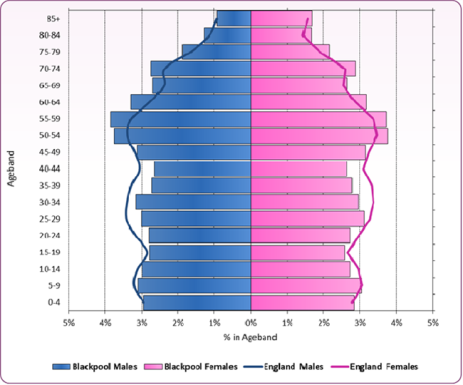
The Office of National Statistics predicts that the overall population of Blackpool will gradually increase over the next 20 years, going from 139,300 in 2018 to 141,500 in 2044. Projections predict that there will be a considerable increase in the proportions of residents aged above 65. The over 65 population is projected to rise by 24% from 28,400 in 2018 to almost 36,000 in 2039. This will then mean that the over 65's will make up over a quarter (26%) of Blackpool's total population.
The chart below shows how the age ranges are predicted to change in Blackpool over the next 20 years.
Looking at the shorter term it is predicted that the proportion of those aged over 65 will increase by 7% between 2020 and 2025 (from 28,000 to 30,000). And the same population will have increased by 18% by 2030 (from 28,000 to 33,000).
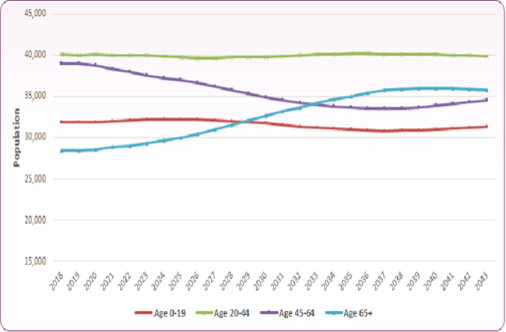
Local market
Capacity
There are 66 registered residential and nursing care homes in Blackpool currently providing a total of 1,618 registered beds:

Current occupancy rates (based on registered beds)
- All providers 91%
- Nursing only 91%
- Residential only 90%
In 2021 one residential home closed which had 31 beds.
Bed availability and capacity (data accurate for March 2022):
- Homes with 1 to 7 beds: There are 9 homes in this size category offering a total of 34 beds of which 3 are available and 2 beds are out of action
- Homes with 8 to 16 beds: There are 14 homes in this size category offering a total of 174 beds of which 6 are available and 6 beds are out of action
- Homes with 17 to 25 beds: There are 16 homes in this size category offering a total of 358 beds of which 7 are available and 23 are out of action
- Homes with 26 to 35 beds: There are 14 homes in this size category offering a total of 423 beds of which 23 are available and 17 are out of action
- Homes with 36 or more beds: There are 13 homes in this size category offering a total of 629 beds of which 23 are available and 43 are out of action
Capacity information
| Home size | Number of homes | Registered beds | Unused capacity | Number of residents |
|---|
| |
|
|
Available |
Out of action |
Occupied |
| 0 to 7 beds |
9 |
34 |
3 |
2 |
29 |
| 8 to 16 beds |
14 |
174 |
6 |
6 |
162 |
| 17 to 25 beds |
16 |
358 |
7 |
23 |
328 |
| 26 to 35 beds |
14 |
423 |
23 |
17 |
383 |
| 36 + beds |
13 |
629 |
23 |
43 |
563 |
The figures above indicate more availability in larger residential homes and less in smaller residential homes.
Location
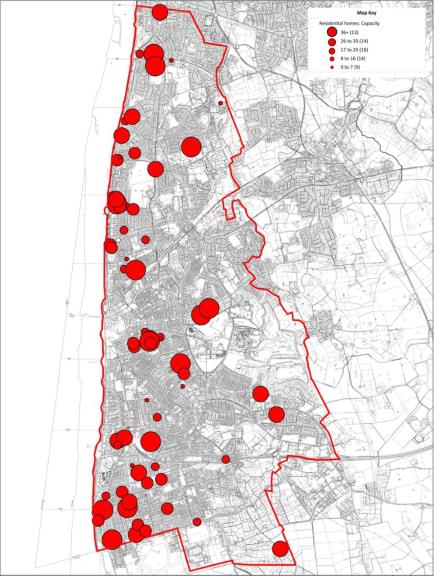

The location of residential and nursing homes cover the majority of Blackpool:
The location of residential and nursing homes is evenly distributed throughout the north, central and south regions of Blackpool.
Registration, specialisms and CQC ratings
The local market mainly consists of providers registered as a private limited company, some homes registered as sole traders, and a smaller number operating with charitable status/voluntary status:
- Sole trader: 13 homes
- Private limited company: 49 homes
- Voluntary sector / Charitable status: 3 homes
Care category
| Specialist care category | No of homes* |
|---|
|
Physical disability
|
29
|
|
Dementia and older people
|
63
|
|
With learning disability
|
8
|
|
With mental health
|
18
|
|
Sensory impairment
|
15
|
*Please note that residential and nursing homes can have multiple specialisms
As might be expected, the local market is primarily able to meet a demand for older people and dementia, with 63 homes specialising in older people and/or dementia care.
Since the last market position statement in 2017, the number of homes providing specialist care in relation to learning disabilities has increased from 3 homes to 8.
Figures in the table below show the percentage of Blackpool residential and nursing homes that fall into each CQC ratings category, when compared with both the regional and national ratings Blackpool exceeds these standards. Going forward we would like to see providers both maintain and improve upon current standards to ensure Blackpool continue to offer high ratings provision.
Details of CQC ratings
| CQC ratings | Blackpool % | North West % | National % |
|---|
|
Outstanding
|
11.1
|
3.02
|
4.46
|
|
Good
|
77.8
|
78.53
|
77.58
|
|
Requires improvement
|
7.9
|
15.92
|
16.09
|
|
Inadequate
|
3.2
|
2.53
|
1.87
|
|
Total
|
100.00
|
100.00
|
100.00
|
Demand
The rate of admission into residential care in Blackpool has fluctuated but has traditionally been higher than national and regional comparators for both the under 65 and over 65 age groups:
Permanent admissions into care per 100,000 population (18 to 64)
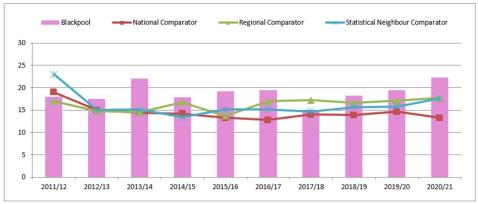
Admissions in the 18 to 64 age range are comparatively small and only show minor changes.
Permanent admissions into care per 100,000 (65+)
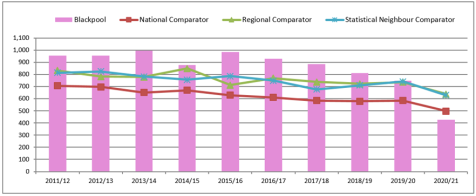
The chart above demonstrates a decrease in the permanent admissions into care in Blackpool, regionally and nationally, and Blackpool appears to be lower for the first time against the regional and national picture. Fully funded health placements are not included in these figures and because of the NHS discharge to assess model there were more health funded admissions for the year 2020/21.
In 2020/21 there were 3 reviews resulting in movement from a residential or nursing placement back into the community during an unplanned review.
At the start of the 2020/21 financial year, Blackpool Council was responsible for funding or arranging 1078 residential and nursing placements in Blackpool.
This figure relates to long and short-term care (excluding respite) for clients aged 18+.
Type of placements
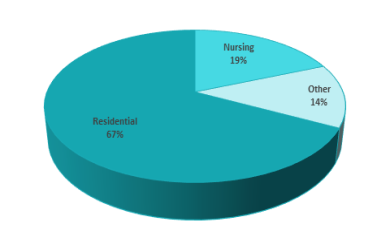
The 'other' client group detailed in the table above relates to learning disability /
mental health or physical disability care placements for under 65's.
Personal care and dementia remain the most prevalent need for clients in residential and nursing placements.
Type of care
| Type | Percentage |
|---|
|
Physical - Access and mobility
|
11.5%
|
|
Carer support
|
0.6%
|
|
Physical - Dual sensory loss
|
0.1%
|
|
Physical - Hearing impairment
|
0.5%
|
|
Learning disability
|
3.8%
|
|
Mental health - Dementia
|
23.6%
|
|
Mental health
|
16.7%
|
|
Physical - Personal care
|
40.4%
|
|
Substance misuse
|
0.4%
|
|
Social
|
1.2%
|
|
Physical - Visual impairment
|
1.3%
|
Duration of placements
Since the current adult social care client management system was introduced in 2013, data has been captured on the average length of residential / nursing home stay (until death) of all Blackpool funded residents.
Information taken during 2020/21 indicates the average length of stay until death was 1107.6 days with 828 days being the median figure, which falls into the 2 to 3 years category as detailed below:
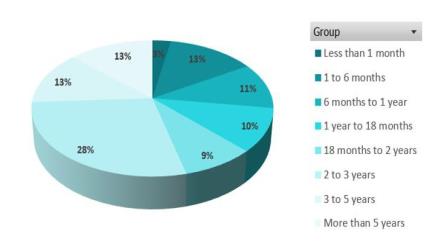
This information tells us that more than half of people placed in residential care lived for 2 years or more before their death. Back in 2016/17 the average length of stay was 620 days or 20 - 21 months with only 29% of people placed in residential care living for more than 2 years. If the market remains static the capacity will reduce.
Out of area placements
At the start of 2020/21, Blackpool Council was responsible for funding 256 out of area residential/nursing placements.
The vast majority of these (75%) were placements within the Lancashire boundary.
Respite
Learning disability
Details
| Total Number of bed nights available per year 2020/21 | Planned respite commissioned 2020/21 | % Occupancy bed occupancy rate |
|---|
|
2160
|
2095
|
97%
|
The above figures are in relation to Blackpool's 6 bed Learning disability respite facility, Cooper's Way. It was identified in our previous Market Position Statement (2017) as an area where demand was rapidly increasing and had exceeded the amount of provision available. Therefore an additional learning disability respite facility has been built and will offer a further 6 beds, meaning Blackpool will have 12 learning disability respite beds available from April 2022 and double the amount of bed nights available each year. The private residential and nursing market have also provided learning disability respite beds which has enabled Blackpool to meet increased demand.
Residential and nursing respite
In the private residential and nursing market, respite can be provided for all service user groups; however, respite beds are not ring-fenced and availability depends on vacancies in the home.
In 2021 the private residential and nursing market provided 1400 bed nights to 85 service users. These figures are lower than what we would typically expect to see, due to Covid-19, families have been at home more to care for service users during the pandemic and some have opted not to place family members in a residential home for respite during this time due to risk of contracting Covid-19 and the potential impact this would have on their health. The majority of service users accessing residential respite would be classed as clinically vulnerable in terms of covid-19.
However, the pandemic has seen an increase in care at home respite and also an increase in direct payments.
Cost of services
Spend
Adult social care represents the largest single revenue expenditure under the control of the local authority. Residential and nursing care is the largest area of spend.
details of spend
| Financial year | Council net budget (£) | Adults services net budget(£) | % Adult services allocated | Residential and nursing spend (£) | % of Adult budget on residential and nursing |
|---|
|
18/19
|
124,366
|
52,224
|
41.99%
|
15,242
|
29.19%
|
|
19/20
|
126,660
|
54,548
|
43.07%
|
15,074
|
27.63%
|
|
20/21
|
142,569
|
62,846
|
44.08%
|
15,518
|
24.69%
|
Fee rates
fee rates information
| Previous classification | 2021/2022
£ P/week | 2022/2033
£ P/Wk | Classification |
|---|
| |
18 to 64 rates |
|
|
| Adults with learning difficulties |
495.67 |
532* |
Standard rate |
| Adults with mental health conditions |
| Adults with a physical/sensory disability |
| |
65 + rates |
|
|
| Standard rate |
495.67 |
532* |
Standard |
| Higher rate |
545.86 |
586.74* |
Higher |
*The increase in rates is to enable providers to pay the real living wage to their staff.
Residents with additional care needs and residents with complex, challenging and unpredictable behaviours
The unit costs listed apply to the majority of residential and nursing homes in Blackpool, however homes managing residents with additional care needs or those with complex, challenging and unpredictable behaviours will often receive extra funding, for example, additional 1:1 hours.
- 194 residential care placements cost more than the standard weekly fee rate and this ranges from £590 to £3600
- 99 nursing placements cost more than the standard weekly fee rate and this ranges from £600 to £2000
- 74 complex, challenging and unpredictable behaviours placements cost more than the standard weekly fee rate and this ranges from £1200 to £2500
- Collective approaches to the recruitment and retention of care staff
- To ensure that mandatory training is readily available, easily accessible and completed by staff
- To ensure compliance with infection control measures including mandatory vaccinations
- Open dialogue and collaborative approaches to business continuity, financial stability, contingency planning and social value including environmental sustainability
- Quick responses to hospital discharge needs
- To ensure providers maintain and improve upon CQC ratings and standards
What we want from the market
- To work with local providers to increase residential capacity in relation to:
- Nursing provision for people with complex, challenging and unpredictable behaviours
- Small to medium capacity homes specialising in complex, challenging and unpredictable behaviours.
- Engagement in future cost of care exercises and aspiration to work towardsan open book costing model
- Commitment to paying the real living wage
- Collective approaches to the recruitment and retention of care staff
- To ensure that mandatory training is readily available, easily accessible and completed by staff
- To ensure compliance with infection control measures including mandatory vaccinations
- Open dialogue and collaborative approaches to business continuity, financial stability, contingency planning and social value including environmental sustainability
- Quick responses to hospital discharge needs
- To ensure providers maintain and improve upon CQC ratings and standards